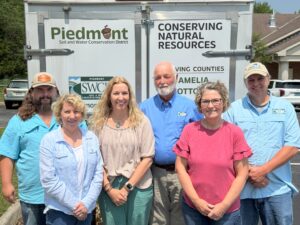Agronomic practice: any conservation practice dealing with plants/vegetation that aims to improve soil quality (example: cover crops)
Best Management Practices (BMPs): a plan that outlines the soil and/or water quality problems of a site and corrects them with the implementation of appropriate conservation practices
Conservation plan: any plan that addresses the water and/or soil quality problems of the field or site on which conservation practices will be implemented; outlines the components of the conservation practice(s) that will be installed to improve water quality and soil health
Cost-share: financial assistance provided as an incentive to install Best Management Practices (BMPs) to conserve soil and water resources
Cover crops: the planting of a vegetated cover on cropland after the harvest of the main crop to help prevent the loss of nutrients from the soil and to reduce soil erosion
Livestock/stream exclusion: fencing livestock out of bodies of water in a field to prevent the direct deposition of animal waste and to reduce sediment deposition caused by livestock traffic down stream banks
No-till farming: the practice of planting through the residues of previous crops instead of tilling the soil before planting; improves soil quality by preventing soil compaction caused by tillage equipment and by adding nutrients to the soil from the breakdown of previous crop residues
Non-point source pollution: pollution that cannot be traced to a single identifiable source such as a pipe or underground storage tank (example: manure running off of livestock grazing fields)
Nutrient management plan: a plan to manage the amount, placement, timing, and application of manure, fertilizer, biosolids, or other material containing nutrients in order to provide the appropriate amount of nutrients to crops and to minimize the runoff of excess nutrients to water bodies
Riparian buffer: vegetated area adjacent to a waterway that improves water quality by slowing down polluted runoff (water that contains manure, fertilizer, and/or sediment) and acting as a natural filter by allowing some of the runoff to seep into the vegetation and soil before entering waterways
Rotational grazing: the practice of moving livestock between fields in order to manage grazing heights and allow for regrowth of vegetation; prevents soil compaction caused by livestock repeatedly walking through the same field over a long period of time
Runoff: water that moves across the ground surface instead of seeping into the soil; as runoff flows, it erodes the soil in its path and channels sediment and pollutants into bodies of water
Stream crossing: a stabilized area or structure built across a stream to provide a travel way for livestock or equipment; prevents damage to the stream bank and streambed
Technical assistance: help provided to land users to address opportunities, concerns, and problems related to the use of natural resources and to help land users make sound natural resource management decisions; this assistance often includes resource assessment, practice design, resource monitoring, or follow-up of installed practices
Total Maximum Daily Load (TMDL): the amount of pollutant a body of water can absorb and still meet water quality standards set by the Department of Environmental Quality. Waters that exceed this amount are classified as impaired.
Watershed: an area of land in which precipitation drains to one common body of water
